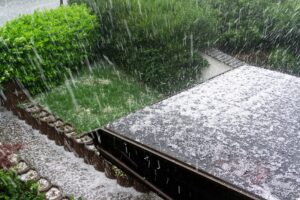Have hailstones damaged your roof?

The Great British weather brings all kinds of gifts, from snow and ice to heatwaves and rain. One of the elements that’s sure to bring attention is hailstones. While a noisy inconvenience (especially if you’re out and about in it!), this type of weather can also damage your roofing. Depending on the size and severity of the hailstorm, you could find your roof has been compromised.
Here’s everything you need to know about hailstone damage on roofs.
How much damage does hail do to a roof?
The extent of roof damage caused by hail will depend on how big the stones are, the condition of your roof materials, how old your roof is, and other storm features like wind speed and roof debris. Even hailstones as small as one inch long can cause roof dents, but even larger ones can crack materials. Older roofs are most at risk, especially if starting out in a poor condition.
Even if your roof gets away with minor damage, something as small as a hairline crack can soon become a bigger problem. For example, if water gets inside the chipped area and expands when solidifying in icy conditions, it can lead to structural damage, leaks and water ingress.
What does a damaged roof look like?
Recognising damaged roofing isn’t always simple. However, there are some key signs to look out for. In tiles, look for dents, missing areas or chips. You may even see some of the underlying structure is exposed. Metal roofing like garages can get dents and puncture marks, causing further issues if you leave them unaddressed.
Compromised roofs can have problems like slipped slates or cracks, which you may find cause internal leaks. Dimples and depressed sections may also be spotted in flat roof materials like EPDM rubber.
How can you tell if hailstones have damaged your roof?
While some roof problems can be easily seen from ground level, it’s not always easy to detect hailstone damage until it’s too late. One area to keep an eye on is your gutters and downpipes, especially in sections underneath tiles. Crumbling debris causes overflowing gutters if it’s blocking the path of rainwater.
You can assess how damaging and intense hailstones were by checking your outdoor spaces after the storm has ended. Larger hailstones can also damage vehicles and furniture. Always check inside your property for leaks and damp spots after heavy rain and hail, as this will indicate a roof puncture.
What should you do next if you have storm-damaged roofing?
Even if you don’t see obvious damage, asking for a professional roof inspection after a hail storm is wise. A roofer can assess damage caused by the storm and may be able to provide you with photographs. Always check your home insurance policy to see what’s covered.
Schedule roof repairs with an experienced contractor to ensure fixes are long-lasting. This will prevent further leaks and structural deterioration.
Contact Collier Roofing
If you think your roof has been damaged by hail or stormy weather, contact us. We offer roof repairs in Surrey, London and surrounding areas, including Warlingham and West Wickham.
For a free quote, get in touch.
